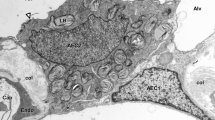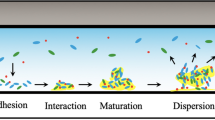Abstract
The pressure during hyperbaric oxygen treatment may increase oxygen toxicity via an augmented oxygen pressure in the gas. Nevertheless, only a few reports have been published on the effect of cells grown under 2 atmospheric absolute (ATA) pressure. To evaluate the effect of pressure on oxygen toxicity and to study effects in addition to oxygen toxicity, we designed an experiment to compare the effects of normobaric mild hyperoxia (NMH, 40% oxygen) and hyperbaric air condition (HA, air with 2 ATA) on human diploid fibroblasts (HDF) in a hyperbaric incubator. HDFs in both the NMH and the HA condition had a similar oxidative stress response and exhibited premature senescence. To investigate differences in gene profiling in cells grown in the NMH and HA conditions, samples from cells exposed to each condition were applied to microarrays. We found no expression difference in genes related to aging and deoxyribonucleic acid damage, but the expression of genes including cell adhesion, stress response, and transcription were significantly increased in fibroblasts that were responsive to pressure. Among 26 statistically reliable genes, the expression of apoptosis related genes such as ADAM22, Bax, BCL2L14, and UBD, as well as tumor suppressor-related genes like Axin2 and ATF, and also mitogen-activated protein kinase-related genes like mitogen-activated protein kinase kinase kinase 1, histamine receptor, and RAB24, were significantly changed in cells responsive to pressure-induced oxidative stress.










Similar content being viewed by others
References
Adams JM, Cory S (1998) The Bcl-2 protein family: arbiters of cell survival. Science 281:1322–1326
Allen RG, Balin AK (2003) Effects of oxygen on the antioxidant responses of normal and transformed cells. Exp Cell Res 289:307–316
Benedetti S, Lamorgese A, Piersantelli M, Pagliarani S, Benvenuti F, Canestrari F (2004) Oxidative stress and antioxidant status in patients undergoing prolonged exposure to hyperbaric oxygen. Clin Biochem 37:312–317
Blobel CP (2002) Functional and biochemical characterization of ADAMs and their predicted role in protein ectodomain shedding. Inflamm Res 51:83–84
Calabrese V, Mancuso C, Sapienza M et al (2007) Oxidative stress and cellular stress response in diabetic nephropathy. Cell Stress Chaperones 12:299–306
Canaan A, Yu X, Booth CJ et al (2006) FAT10/ diubiquitin-like protein-deficient mice exhibit minimal phenotypic differences. Mol Cell Biol 26:5180–5189
Chen QM (2000) Replicative senescence and oxidant-induced premature senescence. Beyond the control of cell cycle checkpoints. Ann NY Acad Sci 908:111–125
Chen Q, Ames BN (1994) Senescence-like growth arrest induced by hydrogen peroxide in human diploid fibroblast F65 cells. Proc Natl Acad Sci USA 91:4130–4134
Chung KH, Kim SH, Han KY et al (2003) Inhibitory effect of salmosin, a Korean snake venom-derived disintegrin, on the integrin alphav-mediated proliferation of SK-Mel-2 human melanoma cells. J Pharm Pharmacol 55:1577–1582
D’Abaco GM, Ng K, Paradiso L, Godde NJ, Kaye A, Novak U (2006) ADAM22, expressed in normal brain but not in high-grade gliomas, inhibits cellular proliferation via the disintegrin domain. Neurosurgery 58:179–186
Davies KJ (1999) The broad spectrum of responses to oxidants in proliferating cells: a new paradigm for oxidative stress. IUBMB Life 48:41–47
Davis RJ (1993) The mitogen-activated protein kinase signal transduction pathway. J Biol Chem 268:14553–14556
Dennog C, Radermacher P, Barnett YA, Speit G (1999) Antioxidant status in humans after exposure to hyperbaric oxygen. Mutat Res 428:83–89
Di Felice V, Ardizzone N, Marcianò V, Bartolotta T, Cappello F, Farina F, Zummo G (2005) Senescence-associated HSP60 expression in normal human skin fibroblasts. Anat Rec A Discov Mol Cell Evol Biol 284:446–453
Dimri GP, Lee X, Basile G et al (1995) A biomarker that identifies senescent human cells in culture and in aging skin in vivo. Proc Natl Acad Sci USA 92:9363–9367
Dowell RT, McManus RE 3rd (1978) Pressure-induced cardiac enlargement in neonatal and adult rats. Left ventricular functional characteristics and evidence of cardiac muscle cell proliferation in the neonate. Circ Res 42:303–310
Feldmeier JJ (2003) Hyperbaric oxygen 2003: indications and results. The Hyperbaric Oxygen Therapy Committee Report UHMS, Undersea and Hyperbaric Medical Society, Kensington, MD, pp 87–100
Gröger M, Speit G, Radermacher P, Muth CM (2005) Interaction of hyperbaric oxygen, nitric oxide, and heme oxygenase on DNA strand breaks in vivo. Mutat Res 572:167–172
Gross A, Jockel J, Wei MC, Korsmeyer SJ (1998) Enforced dimerization of BAX results in its translocation, mitochondrial dysfunction and apoptosis. EMBO J 17:3878–3885
Gutsmann-Conrad A, Heydari AR, You S, Richardson A (1998) The expression of heat shock protein 70 decreases with cellular senescence in vitro and in cells derived from young and old human subjects. Exp Cell Res 241:404–413
Halliwell B (1981) Free radicals, oxygen toxicity and aging. In: Sohal RS (ed) Age pigments. North-Holland Biomedical, Amsterdam, pp 1–6
Hayflick L (1965) The limited in vitro lifetime of human diploid cell strains. Exp Cell Res 37:614–636
Healey C, Forgione P, Lounsbury KM, Corrow K, Osler T, Ricci MA, Stanley A (2003) A new in vitro model of venous hypertension: the effect of pressure on dermal fibroblasts. J Vasc Surg 38:1099–1105
Hishikawa K, Nakaki T, Marumo T, Hayashi M, Suzuki H, Kato R, Saruta T (1994) Pressure promotes DNA synthesis in rat cultured vascular smooth muscle cells. J Clin Invest 93:1975–1980
Hughes TA, Brady HJ (2005a) Cross-talk between pRb/E2F and Wnt/beta-catenin pathways: E2F1 induces axin2 leading to repression of Wnt signalling and to increased cell death. Exp Cell Res 303:32–46
Hughes TA, Brady HJ (2005b) Expression of axin2 is regulated by the alternative 5¢-untranslated regions of its mRNA. J Biol Chem 280:8581–8588
Kang IC, Kim DS, Jang Y, Chung KH (2000) Suppressive mechanism of salmosin, a novel disintegrin in B16 melanoma cell metastasis. Biochem Biophys Res Commun 275:169–173
Kawata Y, Mizukami Y, Fujil Z, Sakumura T, Yoshida K, Matsuzaki M (1998) Applied pressure enhances cell proliferation through mitogen-activated protein kinase activation in mesangial cells. J Biol Chem 273:16905–16912
Kikuchi A (1999) Modulation of Wnt signaling by Axin and Axil. Cytokine Growth Factor Rev 10:255–265
Liu W, Dong X, Mai M et al (2000) Mutations in AXIN2 cause colorectal cancer with defective mismatch repair by activating beta-catenin/TCF signaling. Nat Genet 26:146–147
Mattana J, Singhal PC (1995) Applied pressure modulates mesangial cell proliferation and matrix synthesis. Am J Hypertens 8:1112–1120
Narkowicz CK, Vial JH, McCartney PW (1993) Hyperbaric oxygen therapy increases free radical levels in the blood of humans. Free Radic Res Commun 19:71–80
O’Callaghan-Sunol C, Gabai VL, Sherman MY (2007) Hsp27 modulates p53 signaling and suppresses cellular senescence. Cancer Res 67:11779–11788
Ohashi T, Mizutani A, Murakami A, Kojo S, Ishii T, Taketani S (2002) Rapid oxidation of dichlorodihydrofluorescin with heme and hemoproteins: formation of the fluorescein is independent of the generation of reactive oxygen species. FEBS Lett 511:21–27
Oter S, Korkmaz A, Topal T, Ozcan O, Sadir S, Ozler M, Ogur R, Bilgic H (2005) Correlation between hyperbaric oxygen exposure pressures and oxidative parameters in rat lung, brain, and erythrocytes. Clin Biochem 38:706–711
Pablos MI, Reiter RJ, Chuang JI et al (1997) Acutely administered melatonin reduces oxidative damage in lung and brain induced by hyperbaric oxygen. J Appl Physiol 83:354–358
Patel V, Chivukula IV, Roy S et al (2005) Oxygen: from the benefits of inducing VEGF expression to managing the risk of hyperbaric stress. Antioxid Redox Signal 7:1377–1387
Ren J, Kan A, Leong SH, Ooi LL, Jeang KT, Chong SS, Kon OL, Lee CG (2006) FAT10 plays a role in the regulation of chromosomal stability. J Biol Chem 281:11413–11421
Seals DF, Courtneidge SA (2003) The ADAMs family of metalloproteases: multidomain proteins with multiple functions. Genes Dev 17:7–30
Shyu WC, Lin SZ, Saeki K et al (2004) Hyperbaric oxygen enhances the expression of prion protein and heat shock protein 70 in a mouse neuroblastoma cell line. Cell Mol Neurobiol 24:257–268
Singh NP, McCoy MT, Tice RR, Schneider EL (1988) A simple technique for quantitation of low levels of DNA damage in individual cells. Exp Cell Res 175:184–191
Stanley AC, Lounsbury KM, Corrow K, Callas PW, Zhar R, Howe AK, Ricci MA (2005) Pressure elevation slows the fibroblast response to wound healing. J Vasc Surg 42:546–551
Teiger E, Than VD, Richard L et al (1996) Apoptosis in pressure overload-induced heart hypertrophy in the rat. J Clin Invest 97:2891–2897
Toussaint O, Medrano EE, von Zglinicki T (2000) Cellular and molecular mechanisms of stress-induced premature senescence (SIPS) of human diploid fibroblasts and melanocytes. Exp Gerontol 35:927–945
von Zglinicki T, Saretzki G, Döcke W, Lotze C (1995) Mild hyperoxia shortens telomeres and inhibits proliferation of fibroblasts: a model for senescence? Exp Cell Res 220:186–193
Wada K, Ito M, Miyazawa T, Katoh H, Nawashiro H, Shima K, Chigasaki H (1996) Repeated hyperbaric oxygen induces ischemic tolerance in gerbil hippocampus. Brain Res 740:15–20
Yan C, Lu D, Hai T, Boyd DD (2005) Activating transcription factor 3, a stress sensor, activates p53 by blocking its ubiquitination. EMBO J 24:2425–2435
Yu SY, Chiu JH, Yang SD, Yu HY, Hsieh CC, Chen PJ, Lui WY, Wu CW (2005) Preconditioned hyperbaric oxygenation protects the liver against ischemia-reperfusion injury in rats. J Surg Res 128:28–36
Zhang DW, Jeang KT, Lee CG (2006) p53 negatively regulates the expression of FAT10, a gene upregulated in various cancers. Oncogene 25:2318–2327
Acknowledgments
This research was supported by the grant from the Medical Research Center for Environmental Toxicogenomic and Proteomics (R13-2003-016-00000-0), funded by Korea Science and Engineering Foundation and Ministry of Science and Technology.
Author information
Authors and Affiliations
Corresponding author
Rights and permissions
About this article
Cite this article
Oh, S., Lee, E., Lee, J. et al. Comparison of the effects of 40% oxygen and two atmospheric absolute air pressure conditions on stress-induced premature senescence of normal human diploid fibroblasts. Cell Stress and Chaperones 13, 447–458 (2008). https://doi.org/10.1007/s12192-008-0041-5
Received:
Revised:
Accepted:
Published:
Issue Date:
DOI: https://doi.org/10.1007/s12192-008-0041-5




